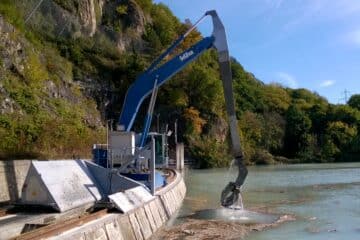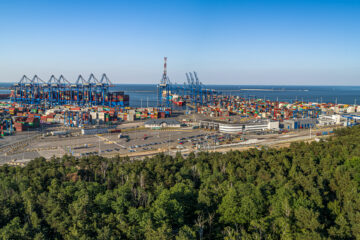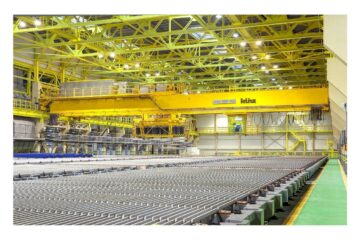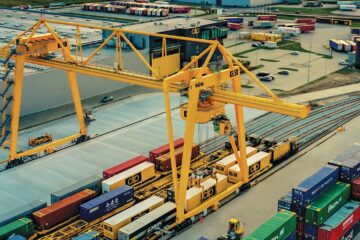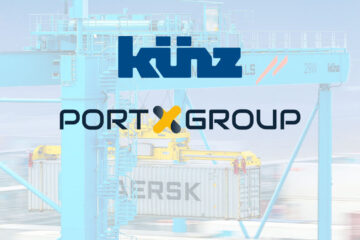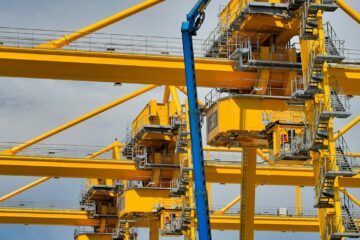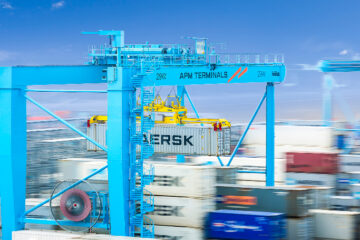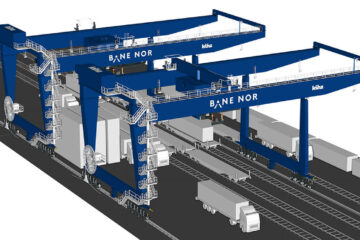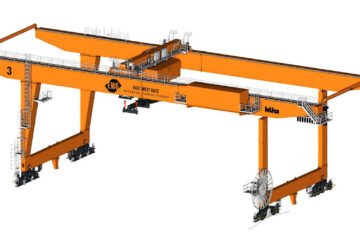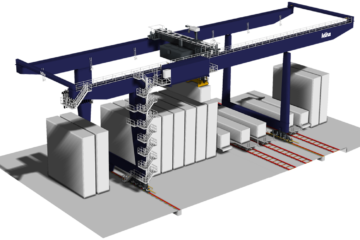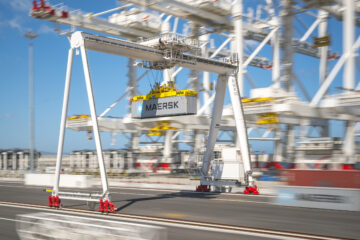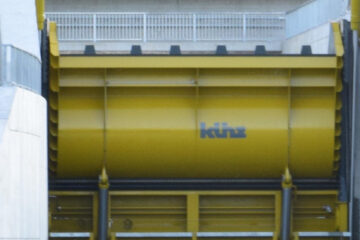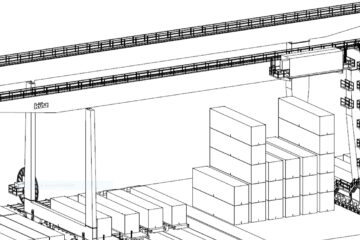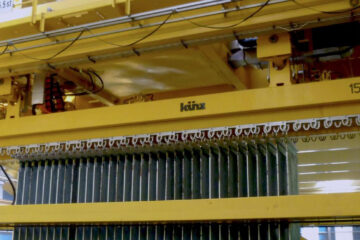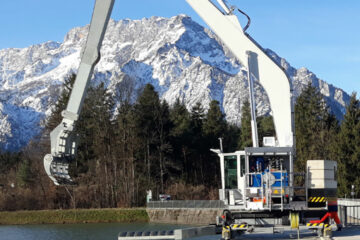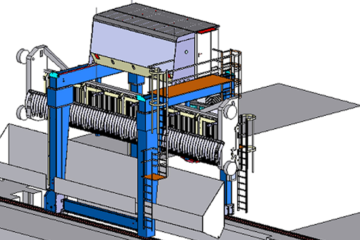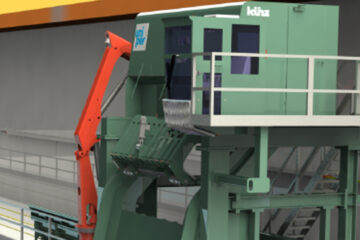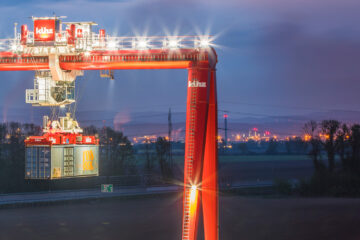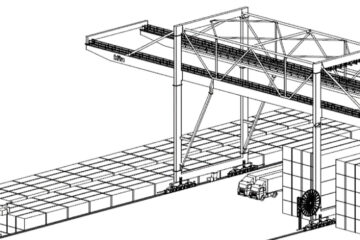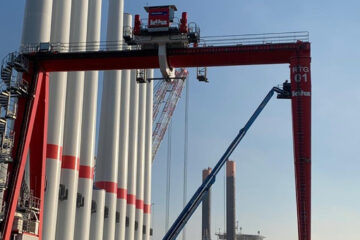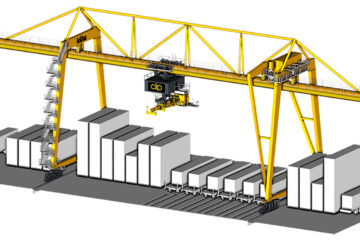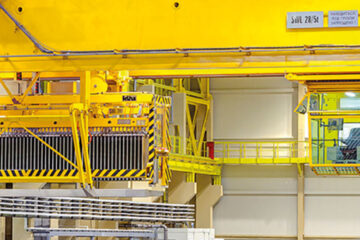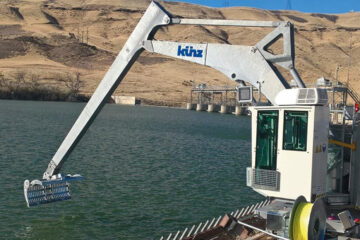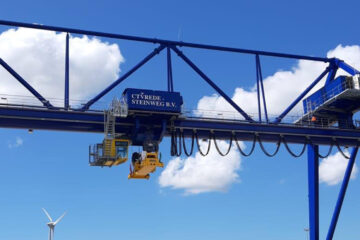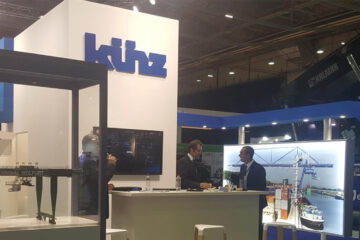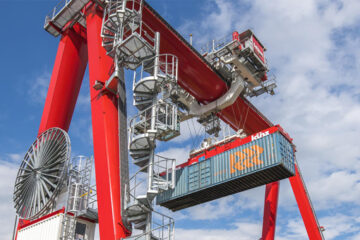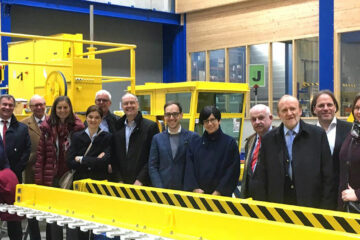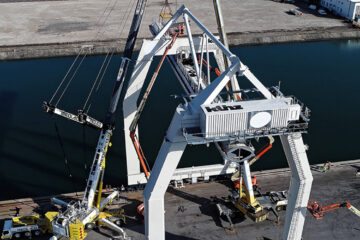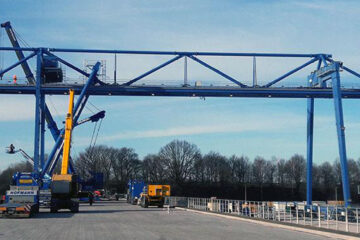The intermodal industry is constantly on the lookout for new solutions to make operations more sustainable. For terminal operators, it is vital to reach their sustainability goals and at the same time improve their performance and cost-efficiency. With new approaches, a fully electric power supply for container handling equipment can be achieved, also in exceptional cases where it was not possible before.
THE INTERMODAL FACILITY OF NORFOLK SOUTHERN IN AUSTELL
Norfolk Southern Corporation is one of the biggest railroad carriers of the United States with many terminals on the East Coast. One of these intermodal terminals is located in Austell just outside Atlanta, Georgia. At this terminal, a major transition takes place – going from “Wheeled operation only” to a combination of “Wheeled operation” and “Ground stacking operation”. So one part of the terminal will be operated by six Kuenz Freerider Rubber Tyred Gantry Cranes (RTGs), which are not only capable of loading and unloading trucks and trains, but also of handling a container stack. With this transition, the space of the terminal will be used more efficiently and as a result, the terminal will more than double its international intermodal capacity.
The Kuenz Freeriders feature the well-known gantry design with an exceptionally stiff and aerodynamic structure. Moreover, an innovative and stiff hoist system with a micro-motion system directly on the trolley and a rotating spreader improves the canes´s productivity. Additional assistance systems such as an anti-collision system and camera views complete the crane features. However, one of the most important aspects in choosing the best RTG solution for a terminal is missing from this list – the power supply.
SYSTEMATICALLY TO THE MOST SUITABLE SOLUTION
In the operation existing today, mainly diesel gensets are the power source for the RTGs. The main problem of an RTG powered by a conventional diesel genset is that the size of the diesel engine is determined by the peak power demand, which occurs only in very specific situations. This means the electric output power of the genset has to be more than 400 kilowatts. However, during most of the operational time, the genset is immensely oversized which leads to very high fuel consumption and emissions. As well as additional challenges through high noise levels and maintenance efforts due to the large capacity genset.
The next and obvious consideration is about a combination of a smaller diesel genset and a Lithium-ion battery as an energy storage system – also known as a diesel-electric hybrid solution. The advantages are manifold. In this case, the diesel genset is only used to charge the battery. Therefore, the required power is much lower (120 kilowatts electrical output) and the power demand is at a constant level.
Moreover, the diesel engine runs only around 50 to 70 per cent of the operational time. The battery is not only charged by the genset, but also by recuperation and reuse of the energy from braking and lowering the loads. This feature increases the savings regarding fuel consumption even more so that in total the savings reach up to 60 per cent. Reduced fuel consumption consequently means a decrease concerning emissions. Compared to the above-mentioned large capacity genset, this hybrid solution would have led to an annual reduction of carbon emissions of more than 1,000 tonnes for six cranes. Taking all aspects including maintenance effort into account, the amortisation period for adding the diesel-electric hybrid solution is typically between two and three years. However, the diesel-electric hybrid is often only an intermediate consideration. Also for Austell the real goal was a zero-emission operation with fully electric RTGs powered by cable reels. Besides the tremendous reduction in operational costs, there is also the benefit of a physical connection to the terminal network via fiber optics in the cable.
Especially to establish the possibility for an upgrade to remote operation at a later stage, fiber optics are the best and most reliable solution for communication between the cranes and the terminal network. Usually, the way to go is a cable reel with a medium-voltage supply using a voltage level of for example 15 kilovolts. Powering the cranes by means of medium-voltage offers the advantage that high power levels can be distributed to the cranes while the cable cross section can be kept relatively small and therefore light and cost-effective. Nevertheless, for many intermodal facilities it can be very challenging to enable a medium-voltage power grid, which would often lead to excessive infrastructure costs. This was also the case at the facility in Austell. So the requirement was that the cranes should be powered by means of a low-voltage supply with 480 volts and furthermore with a maximum shore power of 100 kilowatts. On the other hand, the peak demand of each crane is more than four times higher.
Therefore, Kuenz came up with the idea to implement an energy storage system on each crane.
THE WIDESPREAD BENEFITS OF THE ALL-ELECTRIC HYBRID SOLUTION
A Lithium-ion battery is used as an energy storage system. It is charged on the one hand by the shore power and on the other hand by recuperation and reuse of the energy from braking and lowering the loads. So all the recuperation energy is directly reused on the crane and the demand from the shore power is kept at a constant level of 100 kilowatts. The peak demands of the drives are provided by the energy storage system. In comparison to conventional RTGs, carbon emissions from the diesel engines are entirely eliminated which results in an enormous reduction of more than 2,100 tonnes CO2 for six cranes per year. Furthermore, the operational costs are cut tremendously. On the one hand, because there are no costs for diesel fuel, and on the other hand because of much less maintenance effort and downtime. Moreover, the noise level is reduced significantly and the battery system provides power whenever the cranes are disconnected from the shore power.
For example, when the cranes are changing lanes or driving to a maintenance location. Otherwise, another small genset or small battery would be necessary to provide power for these maneuvers.
FURTHER APPLICATIONS AND OPTIONS
For fully electric powered RTGs there are two main solutions for the shore power supply – cable reel systems and conductor rail systems (also called bus bar systems). Also for the latter one, an all-electric hybrid system can be realised. In this case, the lower and constant power demand enables the advantage of reduced costs concerning the conductor rail system itself.
If it is expected that block changes or lane changes have to be executed very often, there are suitable automated solutions available for both power supply systems. Then the RTG automatically disconnects and connects to the shore power supply before and after the block change.
THREE KEY REASONS FOR IMPLEMENTING ENERGY STORAGE SYSTEMS ON CONTAINER CRANES
All reasons are applicable not only for RTGs but also for Rail Mounted Gantry Cranes (RMGs), which is a new approach in the industry.
• Lowering the voltage level:
The application at the terminal in Austell shows that the energy storage systems make it possible to power the cranes with low-voltage and with a power level of only 100 kilowatts. Besides the benefit of avoiding excessive infrastructure costs for a medium-voltage supply, the low-voltage supply may provide additional advantages in other use cases.
If redundancy is essential, the low-voltage level grid can be backed up by means of one or more stationary gensets.
Furthermore, the maintenance work for medium-voltage equipment requires specially trained staff, which is not the case for low-voltage.
• Peak shaving:
The objective of peak shaving is the minimisation or even avoidance of power peaks.
The reduction of power peaks concerning the RTGs in Austell is already described above. But also for large RMGs an energy storage system leads to a significant decrease regarding peak demands and therefore can reduce so-called peak demand charges as well as subsequently operational costs.
For example, the short-term power peaks of large RMGs, which are higher than 900 kilowatts, can be lowered by 50 per cent. The demand charges are usually calculated based on the average power level within a 15-minute interval. These average power levels can be reduced by 30 to 40 per cent.
• Keeping the energy on the crane:
For terminals with a stable power grid and multiple cranes, the energy from recuperation usually is directly used by other cranes or further terminal systems such as lighting or reefer racks. Then the overall power demand is subsequently close to a constant level.
However, for terminals with few cranes and where recuperation to the grid is not feasible or not cost-effective, an energy storage system on the crane is advantageous as well. Through this, the regenerated energy from the drives is stored in the battery and the overall energy expenses are reduced.
Typically, up to 30 per cent of the energy can be stored and reused. Especially in times of rising energy costs, this is an important aspect.
ABOUT THE AUTHOR:
Philipp Gmeiner is in charge of Product Management for container cranes at Kuenz. Previously he worked for several years as Senior Mechanical Engineer at Kuenz and has a background in Sales Engineering and Project Management for commercial vehicles. He studied at the Vienna University of Technology and KTH Royal Institute of Technology in Stockholm and has a Master’s degree in Mechanical Engineering & Management.
“With the help of Kuenz, we are installing six new, fully electric cranes at our Austell Intermodal terminal,” said Norfolk Southern Director Terminal Operations, Brad Carper. “These electric cranes not only support capacity expansion, but they are also more reliable and will reduce our carbon emissions. Through increased reliability, our customers will have a better experience. Ultimately, this technology will help enable Norfolk Southern to unleash the power of our Intermodal franchise and grow into the future.”
Written for: Technical Paper within Port Technology International – issue 130

